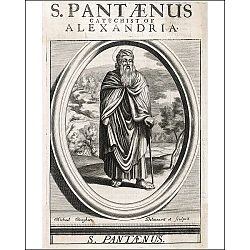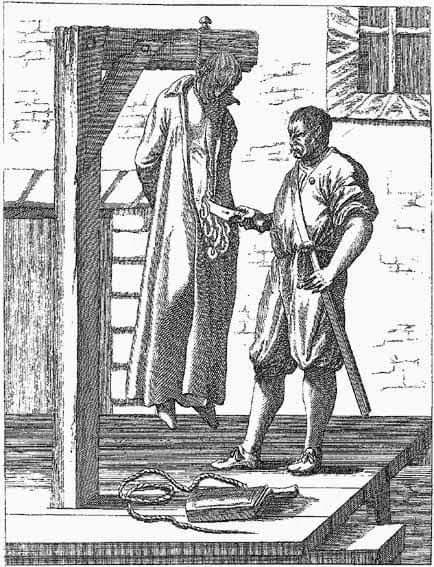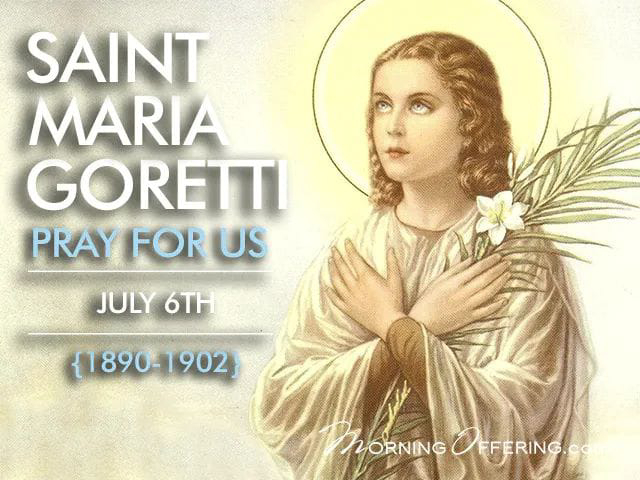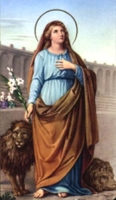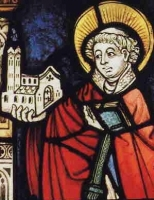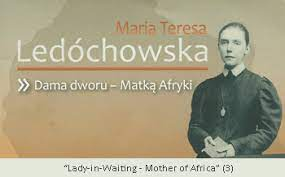St. Illidius
Feastday: July 7
Patron: of Clermont-Ferrand
Death: 385
Bishop of Clermont, France. Also known as Allyre, he was much respected by St. Gregory of Tours. Illidius did much to establish Clermont as a leading monastic and cultural center in the region.
Saint Illidius (French: Saint Allyre, Alyre;[1] died 385) was a 4th-century bishop of Clermont, France.[2] To Illidius is attributed the rise of Clermont-Ferrand as a center of religious teaching and culture.[3] According to tradition, he cured the daughter of the Roman Emperor Magnus Maximus at Trier.[3]
Gregory of Tours mentions Illidius in his work.[3] The fountain of St. Allyre at Clermont is known for its petrifying water, caused by calcareous deposits.
St. Felix of Nantes
Feastday: July 7
Death: 584
Bishop of Nantes, France, known for the cathedral he erected there. A noble of Aquitaine and married, Felix accepted the post of bishop when his wife entered a convent in 549. Felix was noted for his charitable works and for building the cathedral of Nantes. He died there on January 6.
St. Ercongotha
Feastday: July 7
Death: 660
Benedictine nun, the daughter of a king of Kent and St. Sexburga. Also called Ercongota, she was a nun in Faremoutiers-en-Brie, France, at least for a short time, and possibly died there at a young age.
St. Eoban
Feastday: July 7
Death: 754
Benedictine monk and martyr of Irish descent, a companion of Sts. Willibrord and Boniface. Eoban was martyred with Boniface at Dokkum, Holland.
Eoban (died 5 June 754 at Dokkum) was a companion of St. Boniface, and was martyred with him on his final mission. In Germany, he is revered as a bishop and martyr.
Biography
Little is known of Eoban apart from what the Vita Bonifatii says.[1] Apparently, he was an English priest who came to Germany together with St. Boniface. In 753, Willibald's Vita lists him as a Chorbishop. The Fulda martyrology mentions him as a bishop,[2] as does the Vita tertia Bonifatii.[3]
According to the Vita Bonifatii auctore Willibaldo, on the morning of 5 June 754, Boniface and 50 others, presumably including Eoban (none of the companions are mentioned by name in the Vita), were killed at Dokkum (The Netherlands) by pagan Frisians.[4] His cult was of some importance to English Catholics; he is included in the paintings made by Niccolò Circignani of English saints and martyrs in the English College, Rome.[4]
Veneration in Erfurt
After 756 the relics of the bishops of Utrecht Eoban and Adalar were transferred to Fulda, and buried next to St. Boniface. Before 1100 they had been then transferred to Erfurt. Around this time the veneration of the companions of St. Boniface began in Erfurt.
The Sarcophagus containing the relics of the saints Adalar and Eoban in the Erfurt Cathedral is dated from about 1350.
His feast day as a saint is 7 July.
St. Astius
Feastday: July 7
Death: 117
Martyr and bishop. lie was the bishop of Dynhachium in Macedonia when seized and put to death by crucifixion by Roman authorities during the reign of Emperor Trajan. A group of other martyrs, including Peregrinus, Gennanus, Lucian, Pompeius, hesychius, Papius, and Saturninus were also slain because they expressed sympathy for Astius. They were supposedly wrapped in chains and hurled into the sea from the deck of a galley.
St. Ampelius
Feastday: July 7
Death: 672
A bishop of Milan, Italy, during the Lombard period. Ampelius made great missionary efforts among the Lombard people
Blessed Maria Romero Meneses
அருளாளர் மரிய ரொமேரோ மெனெசெஸ்
(Blessed María Romero Meneses)
மறைப் பணியாளர்:
(Religious)
பிறப்பு: ஜனவரி 13, 1902
கிரனடா, நிகரகுவா
(Granada, Nicaragua)
இறப்பு: ஜூலை 7, 1977 (வயது 75)
லஸ் பெனிடஸ், லியோன், நிகரகுவா
(Las Peñitas, León, Nicaragua)
ஏற்கும் சமயம்:
ரோமன் கத்தோலிக்க திருச்சபை
(Roman Catholic Church)
முக்திபேறு பட்டம்: ஏப்ரல் 14, 2002
திருத்தந்தை இரண்டாம் ஜான் பவுல்
(Pope John Paul II)
நினைவுத் திருநாள்: ஜூலை 7
அருளாளர் மரிய ரொமேரோ மெனெசெஸ், ஒரு “நிகரகுவா” (Nicaragua) குடியரசின் ரோமன் கத்தோலிக்க திருச்சபையின் அருட்சகோதரியும், “டான் பாஸ்கோவின் சலேசிய சகோதரிகள்” (Salesian Sisters of Don Bosco) சபையின் ஒப்புக்கொள்ளப்பட்ட உறுப்பினரும், “கோஸ்டா ரிகா’வின்” சமூக அப்போஸ்தலருமாவார். (Social Apostle of Costa Rica).
கி.பி. 1902ம் ஆண்டு, “நிகரகுவா” (Nicaragua) குடியரசில் நடுத்தர குடும்பத்தில் பிறந்த ரொமேரோ’வின் தந்தை பெயர் “ஃபெலிக்ஸ்” (Félix Romero Arana) ஆகும். தாயாரின் பெயர், “அனா” (Ana Meneses Blandon) ஆகும். இவர் தமது பெற்றோரின் எட்டு குழந்தைகளில் ஒருவர் ஆவார். பிறந்து ஒரு வாரத்திலேயே திருமுழுக்கு பெற்றார். 1904ம் ஆண்டு, ஜூலை மாதம், 23ம் தேதி, உறுதிப்பூசுதல் (Confirmation) அருட்சாதனம் பெற்ற இவர், 1909ம் ஆண்டு, டிசம்பர் மாதம், 8ம் தேதி, “புதுநன்மை” (First Communion) அருட்சாதனம் பெற்றார்.
கலையிலும் சங்கீதத்திலும் ஆர்வம் கொண்டு வளர்ந்ததால், இவருடைய பெற்றோர் இவருக்கு வயலின் மற்றும் பியானோ ஆகிய இசைக் கருவிகளை வாசிக்க கற்பித்தனர். பின்னர், “டான் பாஸ்கோவின் சலேசிய சகோதரிகள் பள்ளியில்” இணைந்து கல்வி கற்க ஆரம்பித்தார். எனினும் 1914ம் ஆண்டில் அவர் “வாதம் சம்பந்தமான காய்ச்சலால்” (Rheumatic Fever) நீண்ட காலம் பாதிப்படைந்தார். அக்காய்ச்சல், அவரது மீதமுள்ள வாழ்நாள் முழுதும் இருதய பாதிப்பை விட்டுச் சென்றது. ஆனால், அதிலிருந்து அவர் மீண்டபோது, அது இயற்கையிலேயே அற்புதமானதாக கருதப்பட்டது.
பூரண நம்பிக்கையுள்ள இப்பெண், 1915ம் ஆண்டு, டிசம்பர் மாதம், 8ம் நாளன்று, “கிறிஸ்தவர்களின் சகாய அன்னை மரியாளின் மகள்கள்” (Daughters of Mary Help of Christian) எனும் “மரியான் சமூகத்தில்” (Marian association) இணைந்தார். 1929ம் ஆண்டு, ஜனவரி மாதம், 6ம் தேதி, அவர் தமது இறுதி வார்த்தைப் பாட்டை ஏற்றார்.
1931ம் ஆண்டு, “கோஸ்டா ரிகா” (Costa Rica) தீவின் தலைநகரான “சேன் ஜோஸ்” (San Jose) சென்றார். இது இவரது இரண்டாவது தாய் நாடாக கருதப்படுகிறது. 1933ம் ஆண்டு, கலை மற்றும் சங்கீதம் ஆகியவற்றின் ஆசிரியையானார். அங்குள்ள பள்ளியில் பணக்கார குழந்தைகளுக்கு தட்டச்சு கற்றுக்கொடுத்தார். பெரும் எண்ணிக்கையிலுள்ள அவரது மாணவர்கள் அவரைப்போன்றே அவருடன் இணைந்து ஏழைகளுக்கு சேவை செய்தனர். அவரது கவனம் சமூக அபிவிருத்தியில் இருந்தது. 1945ம் ஆண்டு பொழுதுபோக்கு மையங்களைத் தொடங்கிய இவர், 1953ம் ஆண்டில் உணவு விநியோக மையங்களையும் தொடங்கினார். 1961ம் ஆண்டில் ஏழை சிறுமிகளுக்காக பள்ளி ஒன்றினை நிறுவினார். 1966ம் ஆண்டு, நோயுற்றோருக்காக மருந்தகம் ஒன்றினையும் நிறுவினார். 1973ம் ஆண்டு, ஏழை குடும்பங்களுக்காக ஏழு இல்லங்களை கட்டினார்.
1977ம் ஆண்டு, “லியோன்” (Leon) நகரிலுள்ள “சலேசிய அருட்சகோதரிகளின்” இல்லத்தில் (Salesian Sisters house) ஓய்வுக்காக அனுப்பப்பட்டிருந்த மரிய ரொமேரோ மெனெசெஸ் மாரடைப்பால் தாக்குண்டு மரணமடைந்தார்.
Also known as
• the female John Bosco
• Daughter of Mary Help of Christians
• Social Apostle of Costa Rica
Profile
One of eight children born to a wealthy, upper-class family; her father was a government minister. Educated by her family, tutors and at the local Salesian Sisters' school, she could play piano and violin, studied drawing, and loved to learn. At the age of twelve she spent a year extemely sick from rheumatic fever; she was paralyzed for six months and her heart was permanently damaged. She was cured by the intercession and apparition of Our Lady, Help of Christians, during which vision she understood her vocation to be a Salesian sister.
On 8 December 1915, Maria joined the Marian Association's Daughters of Mary. She joined the Daughers of Mary, Help of Christians in 1920, and on 6 January 1929 in Nicaragua, Maria made her final profession as a Salesian. Transferred to San Jose, Costa Rica in 1931. Taught music, drawing and typing to rich school girls, trained catechists and trades to the poor. Many of her students were won over to her way of life, and worked with her to help the poor and abandoned.
Maria developed a ministry of fund raising and of showing the wealthy practical ways to bring their charity to the poor. She began to set up recreational centers in 1945, and food distribution centers in 1953. She opened a school for poor girls in 1961, and 1966 a clinic staffed by volunteer doctors. In 1973 she organized the construction of seven homes, which became the foundation of the village of Centro San Jose, a community were poor families could have decent homes. An excellent teacher, manager and fund-raiser, she was known for her way of bringing God to people one on one, bringing love and devotion to the Eucharist to social improvements.
Born
13 January 1902 at Granada, Nicaragua
Died
• 7 July 1977 in Las Peñitas, León, Nicaragua of a heart attack
• Salesian chapel, San José, Costa Rica
Beatified
14 April 2002 by Pope John Paul II
Saint Willibald of Eichstätt
புனித.வில்லிபால்டு (St.Willibald)
ஆயர்
பிறப்பு
22 அக்டோபர் 700
தென் இங்கிலாந்து
இறப்பு
7 ஜூலை 787
ஐஷ்டாட்(Eichstatt) , ஜெர்மனி
பாதுகாவல்: ஐஷ்டாட் நகரின் பாதுகாவலர்
வில்லிபால்டு தென் இங்கிலாந்து நாட்டில் ரிச்சர்டு என்பவரின் மகனாக பிறந்தார். 720 ஆம் ஆண்டு தந்தை ரிச்சர்டு, உடன் பிறந்த சகோதரர் உன்னிபால்டும்(Wunibald) உரோம் நகரை நோக்கி திருப்பயணம் மேற்கொண்டனர். அப்போதுதான் இவரின் தந்தை லக்கா(Lucca) என்னுமிடத்தில் இறந்துவிட்டார். அப்போது வில்லிபால்டு உரோம் நகரிலேயே தங்கினார். இரண்டரை ஆண்டுகள் கழித்து இவர் பாலஸ்தீன மற்றும் கொன்ஸ்டாண்டீனோபிள் நோக்கி பயணம் மேற்கொண்டார். 729 ஆம் ஆண்டு அங்கிருந்து மீண்டும் இத்தாலி நாட்டிற்கு வந்தடைந்தார். அப்போதுதான் இவர் புனித பெனடிக்ட் துறவற சபையில் சேர்ந்தார்.
739 ஆம் ஆண்டு திருத்தந்தை 3ஆம் கிரகோரி அவர்களால் குருவாக திருநிலைப்படுத்தப்பட்டார். பின்னர் தன்னுடன் குருப்பட்டம் பெற்ற போனிபாஸ் என்பவருடன் சேர்ந்து ஜெர்மனி நாட்டிற்கு அனுப்பப்பட்டார். அங்கு அப்போஸ்தலர் பணியை சிறப்பாக செய்தபின் 741 ல் ஆயராக திருநிலைப்படுத்தப்பட்டார். ஆயரான பிறகும் கூட தனது மிஷனரி பணியை பவேரியா மறைமாநிலம் முழுவதிலும் சிறப்பாக செய்தார். 741- 787 ஆம் ஆண்டு வரை ஐஷ்டாட் என்ற மறைமாநிலத்தில் ஆயராக பணியாற்றினார். இவர் ஐஷ்டாட் மறைமாநிலத்தின் முதல் ஆயர் என்ற பெருமையை பெற்றார். இவர் 8 ஆம் நூற்றாண்டில் இவரின் பெயரால் ஐஷ்டாட்டில் பேராலயம் ஒன்றை எழுப்பினார். இவ்வாலயத்தில்தான் வில்லிபால்டு அவர்களின் கால்கள் வைக்கப்பட்டுள்ளது. உரோமில் உள்ள புனித பேதுரு பேராலயத்தில் இவரின் உடல் அடக்கம் செய்யப்பட்டது.
1745 ஆம் ஆண்டு இவரின் 1000 ஆம் வருட ஜூபிலியை முன்னிட்டு, இவரது கல்லறையை பேதுரு பேராலயத்திலிருந்து ஐஷ்டாட்டிற்கு மாற்றப்பட்டது. இவர் வாழும்போதே ஆலயத்தில் பாடப்படும் பாடற்குழுவிற்கென ஓர் அழகிய மேடையை அமைத்தார். அவர் திருப்பலி ஆற்றும் போதெல்லாம், ஐஷ்டாட்டில் வாழும் ஒவ்வொருவரும் புனிதர்களே" என்று தவறாமல் கூறிவருவார்.
Also known as
Willebald
Profile
Born a prince, the son of Saint Richard the King. Brother of Saint Winnebald of Heidenheim and Saint Walburga. Related to Saint Boniface. He nearly died as an infant, leading his parents to pray for his life, vowing that he would be dedicated to God if he survived. Entered the Abbey of Waltham, Hampshire, England at age five. Educated by Egwald. Benedictine monk. Pilgrim to Rome, Italy in 722 with Saint Richard and Saint Winnebald; his father died on the way, and Willibald suffered from malaria while there.
Pilgrim to the Holy Lands in 724. He reached Jerusalem on 11 November 725, and is the first known Englishman in the Holy Land; the book of his travels, Hodoeporicon, is the first known English travelogue. Pilgrim to assorted holy sites throughout Europe. At one point he was arrested by Saracens at Emessa as a Christian spy, and imprisoned in Constantinople.
Willibald then spent ten years helping Saint Petronax restore the monastery of Monte Cassino; served there as sacristan, dean, and porter. In 740 he was sent by Pope Gregory III to help Saint Boniface evangelize the area that is modern Germany. Ordained on 22 July 741 by Saint Boniface, and consecrated as a missionary bishop by him on 21 October 741. Founded a missionary monastery in Eichstätt, Franconia (in modern Germany. Worked with Saint Sebaldus. First bishop of the diocese of Eichstätt. With Saint Winnebald, he founded the double monastery at Hiedenheim in 752.
Born
21 October 700 in Wessex, England
Died
• 7 July 781 of natural causes
• relics kept in a marble reliquary urn in Saint Willibald Cathedral, Eichstätt, Germany, which was completed in 1269
Canonized
938 by Pope Leo VII
Patronage
diocese of Eichstätt, Germany
Blessed Pope Benedict XI
Also known as
Niccolo Boccasini
Profile
He joined the Dominicans when a young man, and became 9th Master-General of his Order in 1296. Arranged an armistice between Philip IV of France and Edward I of England. Created Cardinal-Bishop of Ostia, Italy by Pope Boniface VIII. Papal legate. Defended Pope Boniface VIII against William of Nogaret and his allies.
Unanimously chosen 194th pope in 1303. Removed papal censure from Philip and France, and absolved the cardinals favoring Colonna political faction. Accomplished a number of reforms in religious and clerical life. Believed to have been poisoned by the agents of William of Nogaret. Known for his lifelong devotion to Dominican spiritual practices. Author of a volume of sermons and commentaries on the Gospel of Matthew, the Psalms, the Book of Job, and Revelations.
Born
1240 at Treviso, Italy as Niccolo Boccasini
Papal Ascension
22 October 1303
Died
7 July 1304 at Perugia, Italy of natural causes
Beatified
• 24 April 1736 by Pope Clement XII (cultus confirmed)
• 1773 by Pope Clement XIV (beatified)
Blessed Peter To Rot
Profile
Son of Angelo To Puia, a village chief, and Maria la Tumul, an adult converts who were part of the region's first generation of Catholics. Peter was a pious boy, and though somewhat drawn to religious life, he became a lay catechist and worked with missionaries in the area. An excellent teacher and organizer of classes, he constantly carried and taught from his Bible. Married to Paula la Varpit on 11 November 1936. Father of three; one child died in infancy, another soon after the War.
In 1942 all the missionaries and their staff were arrested by the invading Japanese armies, and were lodged in concentration camps. Peter continued to lead the faithful of his village as best he could, caring for the sick, Baptising and teaching the converts, helping the poor. When the War began to go against them, the Japanese began to repress the locals, forbidding Christianity, and pushing for a return to pre-Christian ways, particularly of polygamy. Peter opposed the regression, and was arrested in 1945 for conducting religious gatherings. Imprisoned in a cave, he was so well known, supported and beloved by those who knew him that he continued to be a source of strength to his people, and of annoyance to his captors. Martyr.
Born
1912 in Rakunai, East New Britain (part of modern Papua New Guinea)
Died
poisoned and suffocated on 7 July 1945 in a Japanese concentration camp at Rakunai, East New Britain (part of modern Papua New Guinea)
Beatified
17 January 1995 by Pope John Paul II
Blessed Ralph Milner
Also known as
Randolph, Ranulphe, Raoul, Rodolfo
Profile
Poor, uneducated but pious farmer, husband and father of eight children in 16th century England. Raised an Anglican, he converted to Catholicism. He was arrested on the day of his First Communion for the crime of converting. He was such a model prisoner that the jailers gave him keys so he could go out to work and return to serve his sentence. He used this as a way to get a priest, including Blessed Roger Dickenson, into the jail to minister to other Catholic prisoners. Arrested with Father Roger for the crimes of helping a priest, attending Mass and helping fellow Catholics during the persecutions of Queen Elizabeth I. He was given the chance for pardon if he would renounce Catholicism and attend a Protestant church; he declined. They brought his children to the jail in hopes of changing his mind; he gave them a father‘s blessing, and continued his preparation for execution. Martyr.
Born
Slackstead, Hampshire, England
Died
hanged on 7 July 1591 in Winchester, Hampshire, England
Beatification
15 December 1929 by Pope Pius XI
Blessed Juan Antonio Pérez Mayo
Memorial
28 November as one of the Oblate Martyrs of the Spanish Civil War
Profile
One of seven children born to Modesto Pérez and Beatriz Mayo; his was a pious family, and Juan was baptized on 23 March 1908. Member of the Tarsicios, a religious association for children; at age 14 he started doing over-night Eucharistic adoration and started talking about becoming a missionary. Member of the Missionary Oblates of Mary Immaculate, making his first profession on 15 August 1927. Studied at the Pontifical University of Saint Thomas in Rome, Italy, made his perpetual vows in 1930, and was ordained on 26 June 1932. Worked in the Basque region in 1934, then in Madrid in 1935 where he taught philosophy. Arrested on 22 July 1936 by anti-Catholic forces fighting in the Spanish Civil War, he was imprisoned for a couple of days then martyred for his faith.
Born
19 November 1907 in Santa Marina del Rey, diocese of Astorga, León, Spain
Died
shot on 24 July 1936 in Pozuelo de Alarcon, Madrid, Spain
Beatified
17 December 2011 by Pope Benedict XVI
Saint Marcus Ji Tianxiang
Also known as
Magu, Marco, Mark
Additional Memorial
28 September as one of the Martyrs of China
Profile
Married layman in the apostolic vicariate of Southeastern Zhili, China. Father. Physician. An opium addiction led to him being forbidden to take Communion, and though he could not break his dependency for 30 years, he never lost his faith, never wanted to leave the Church, and when he was finally clean, he returned to full communion. Martyred in the Boxer Rebellion.
Born
c.1834 in Yazhuangtou, Jizhou, Hebei, China
Died
beheaded on 7 July 1900 in Yazhuangtou, Jizhou, Hebei, China
Canonized
1 October 2000 by Pope John Paul II
Blessed Marie-Gabrielle-Françoise-Suzanne de Gaillard de Lavaldène
Also known as
• Francesca Maria Susanna
• Ifigenia di S. Matteo de Gaillard de la Valdène
• Sister Iphigénie of Saint Matthew
Additional Memorial
9 July as one of the Martyrs of Orange
Profile
Sacramentine nun. Martyred in the French Revolution.
Born
23 September 1761 in Bollène, Vaucluse, France
Died
guillotined on 7 July 1794 in Orange, Vaucluse, France
Beatified
10 May 1925 by Pope Pius XI
Saint Ethelburga of Faremoutier
Also known as
Aubierge, Edelburga, Edilberga
Profile
Daughter of the king of East Angles. During her childhood, Ethelburga lived in a Gallic convent under the direction of Saint Burgundofara, a home she would have for the rest of her life. She was known throughout the community for her adherence to the Rule of the Order. In the mid-seventh century, Ethelburga was chosen abbess. She ruled with wisdom and justice until her death. Saint Tortgith of Barking was one of her nuns.
Died
• 664 at Faremoutier, France of natural causes
• when her body was exhumed seven years after her death, it was found incorrupt
Saint Antonino Fantosati
Also known as
• Antoninus Fantosati
• Antonio Fantosati
• Anthony Fantosat
Additional Memorial
28 September as one of the Martyrs of China
Profile
Priest. Franciscan missionary bishop. Vicar apostolic for southern Hunan, China. One of the Martyrs of China, killed during the Boxer Rebellion.
Born
16 October 1842 at Santa Maria della Valle, Umbria, Italy
Died
4 July 1900 in Hengzhou, Hunan, China
Canonized
1 October 2000 by Pope John Paul II
Saint Maelruan
Also known as
Maolruain, Melruan, Molruan
Profile
Founder and first Abbot of Tamalcht Abbey, County of Dublin, Ireland in 769 on land given by Donnchadh, King of Leinster. With Saint Aengus the Culdee he wrote the Rule of Célidhé Dé, "a minute series of rules for the regulation of the lives of the Célidhé Dé, their prayers, their preachings, their conversations, their confessions, their communions, their ablutions, their fastings, their abstinences, their relaxations, their sleep, their celebrations of the Mass, and so forth".
Died
791 at Ulster, Ireland
Blessed Joseph Juge de Saint-Martin
Profile
Sulpician priest. Imprisoned on a ship in the harbor of Rochefort, France and left to die during the anti-Catholic persecutions of the French Revolution. One of the Martyrs of the Hulks of Rochefort.
Born
14 June 1739 in Limoges, Huate-Vienne, France
Died
7 July 1794 aboard the prison ship Deux-Associés, in Rochefort, Charente-Maritime, France
Beatified
1 October 1995 by Pope John Paul II
Blessed Oddino Barrotti
Also known as
• Oddino of Fossano
• Oddin...
Profile
Priest at Saint John the Baptist Church, Fossano, Italy. Franciscan tertiary. Eventually resigned his parish and turned his house into a hospital. In 1396 he agreed to serve as director of the collegiate chapter in Fossano. Died while working with the sick during a plague epidemic.
Born
1324 at Fossano, Piedmont, Italy
Died
1400 in Fossano, Italy of plague
Beatified
1808 by Pope Pius VII (cultus confirmation)
Blessed Juan Pedro del Cotillo Fernández
Memorial
28 November as one of the Oblate Martyrs of the Spanish Civil War
Profile
Priest. Member of the Missionary Oblates of Mary Immaculate. Martyr.
Born
1 May 1914 in Siero de la Reina, León, Spain
Died
shot on 24 July 1936 in Pozuelo de Alarcon, Madrid, Spain
Beatified
17 December 2011 by Pope Benedict XVI
Saint Apollonius of Brescia
Profile
Second century bishop of Brescia, Italy. Baptized Saint Afra of Brescia. The Acts of Saints Faustinus and Jovita say that Apollonius was the bishop who ordained them.
Died
• buried in the church of Saint Andrew at Brescia, Italy
• relics later enshrined in the Cathedral of the Assumption in Brescia, Italy
Blessed Francisco Polvorinos Gómez
Memorial
28 November as one of the Oblate Martyrs of the Spanish Civil War
Profile
Priest. Member of the Missionary Oblates of Mary Immaculate. Martyr.
Born
29 January 1910 in Calaveras de Arriba, León, Spain
Died
shot on 24 July 1936 in Pozuelo de Alarcon, Madrid, Spain
Beatified
17 December 2011 by Pope Benedict XVI
Blessed Manuel Gutiérrez Martín
Memorial
28 November as one of the Oblate Martyrs of the Spanish Civil War
Profile
Priest. Member of the Missionary Oblates of Mary Immaculate. Martyr.
Born
1 January 1913 in Fresno del Río, Palencia, Spain
Died
shot on 24 July 1936 in Pozuelo de Alarcon, Madrid, Spain
Beatified
17 December 2011 by Pope Benedict XVI
Blessed Justo González Lorente
Memorial
28 November as one of the Oblate Martyrs of the Spanish Civil War
Profile
Priest. Member of the Missionary Oblates of Mary Immaculate. Martyr.
Born
14 October 1915 in Villaverde de Arcayos, León, Spain
Died
shot on 24 July 1936 in Pozuelo de Alarcon, Madrid, Spain
Beatified
17 December 2011 by Pope Benedict XVI
Saint Odo of Urgell
Also known as
• Ot of Urgell
• Dot of Urgell
Profile
Oldest son of a Spanish Count of of Pallars Sobirà. Soldier. Archdeacon in Urgell, Spain. Bishop of Urgell in 1095. Noted for his care for the poor.
Born
c.1065
Died
• 1122 of natural causes
• buried in the monastery of Santa Maria de Gerri
Canonized
1133
Patronage
La Seu d'Urgell, Spain
Blessed María Del Consuelo Ramiñán Carracedo
Also known as
Isabel
Profile
Nun of the Franciscan Missionaries of the Divine Motherhood. Martyred in the Spanish Civil War.
Born
17 June 1876 in Seavía, La Coruña, Spain
Died
7 July 1936 in Madrid, Spain
Beatified
13 October 2013 by Pope Francis
Blessed Pascual Aláez Medina
Memorial
28 November as one of the Oblate Martyrs of the Spanish Civil War
Profile
Priest. Member of the Missionary Oblates of Mary Immaculate. Martyr.
Born
11 May 1917 in Villaverde de Arcayos, León, Spain
Died
shot on 24 July 1936 in Pozuelo de Alarcon, Madrid, Spain
Beatified
17 December 2011 by Pope Benedict XVI
Saint Hedda of Wessex
Profile
• Hedda of Dorchester
• Hedda of Winchester
Profile
Benedictine monk. Abbot at Whitby, Yorkshire, England. Bishop of the Wessex, England region in 676; he served for almost 40 years. Established his see at Dorchester, then Winchester. Adviser to King Ina.
Born
England
Died
705 of natural causes
Saint Pantaenus of Alexandria
Also known as
Sicilian Bee
Saint Pantaenus the Philosopher (Greek: Πάνταινος; died c. 200)[4] was a Greek theologian and a significant figure in the Catechetical School of Alexandria from around AD 180. This school was the earliest catechetical school, and became influential in the development of Christian theology.
Biography
Pantaenus was a Stoic philosopher teaching in Alexandria. He was a native of Sicily.[5] He converted to the Christian faith, and sought to reconcile his new faith with Greek philosophy. His most famous student, Clement,[6] who was his successor as head of the Catechetical School, described Pantaenus as "the Sicilian bee".[7] Although no writings by Pantaenus are extant,[8] his legacy is known by the influence of the Catechetical School on the development of Christian theology, in particular in the early debates on the interpretation of the Bible, the Trinity, and Christology. He was the main supporter of Serapion of Antioch for acting against the influence of Gnosticism.
In addition to his work as a teacher, Eusebius of Caesarea reports that Pantaenus was for a time a missionary,[9] traveling as far as India where, according to Eusebius, he found Christian communities using the Gospel of Matthew written in "Hebrew letters", supposedly left them by the Apostle Bartholomew (and which might have been the Gospel of the Hebrews).[10][11] This may indicate that Syrian Christians, using a Syriac version of the New Testament, had already evangelized parts of India by the late 2nd century. However, some writers have suggested that having difficulty with the language of Saint Thomas Christians, Pantaenus misinterpreted their reference to Mar Thoma (the Aramaic term meaning Saint Thomas), who is currently credited with bringing Christianity to India in the 1st century[12][13] by the Syrian Churches, as Bar Tolmai (the Hebrew name of Bartholomew). The ancient seaport Muziris on the Malabar Coast (modern-day Kerala in India) was frequented by the Egyptians in the early centuries AD.[14]
Saint Jerome (c. 347 – 30 September 420), apparently relying entirely on Eusebius' evidence from Historia Ecclesiastica, wrote that Pantaenus visited India, “to preach Christ to the Brahmans and philosophers there.”[15] It is unlikely that Jerome has any information about Pantaenus' mission to India that is independent of Eusebius. On the other hand, his claim that "many" of Pantaenus' Biblical commentaries were still extant is probably based on Jerome's own knowledge.
The Coptic synaxarium mentions "Pantaenus and Clement" in its entry regarding the return of the relics of St Mark the Apostle by Pope Paul VI of Rome on 15 Paoni[19][20][21] but does not assign Pantaenus any specific feast date.
The Universalist Church of America historian J. W. Hanson (1899) argued that Pantaenus "must, beyond question" have taught Universalism to Clement of Alexandria and Origen.[22] However, since it is now considered that Clement of Alexandria's views contained a tension between salvation and freewill,[23] and that he and Origen did not clearly teach universal reconciliation of all immortal souls in their understanding of apokatastasis, Hanson's conclusion about Pantaenus lacks a firm basis.[2
Died
c.190
Saint Syrus of Genoa
Also known as
Siro
Profile
Parish priest. Bishop of Genoa, Italy.
Died
• c.380 of natural causes
• buried in the Basilica of the Twelve Apostles
Patronage
Genoa, Italy
Blessed Bodard of Poitiers
Profile
Hermit near Poitiers, France.
Born
late 7th century near Poitiers, France
Died
• c.740 near Poitiers, France of natural causes
• relics translated to the Hornback monastery at Zweibrücken, Germany in the 9th century
Saint Carissima of Rauzeille
Also known as
Careme
Profile
Born to the Gallic nobility. Married. Mother. Widow. Helped found the abbey of Saint-Martin in Rauzeille near Aubusson, Creuse, Gaul (in modern France).
Born
7th century Limousin, France
Saint Hesychius
Profile
Fled to Macedonia to escape the persecutions in Italy, but martyred en route.
Born
Italian
Died
drowned by being loaded with chains and thrown overboard c.117
Saint They
Also known as
Dei, Dey, Teï, Tey
Profile
Fifth century spiritual student of Saint Guénolé at Landévennec abbey in Brittany.
Patronage
Lothey, France
Saint Bonitus of Monte Cassino
Profile
Abbot of Monte Cassino when the invading Lombards plundered and destroyed the monastery.
Died
c.582
Saint Angelelmus of Auxerre
Profile
Abbt of the monastery of Saint Gervase and Protase in Auxerre, France. Bishop of Auxerre.
Died
828
Saint Eoaldus of Vienne
Also known as
Eoalde
Profile
Related to Gallic royalty. Bishop of Vienne, France.
Died
716 of natural causes
Saint Prosper of Aquitaine
Profile
Married layman who devoted himself to theology.
Born
c.390 in Aquitaine, France
Died
436
Saint Odran
Profile
Brother of Saint Medran. Disciple of Saint Kieran of Saghir.
Saint Merryn
Profile
Venerated in Cornwall, England, but no information about his survived.
Saint Medran
Profile
Brother of Saint Odran. Disciple of Saint Kieran of Saghir.
Saint Alexander
Profile
Martyr.
Saint Partinimus
Profile
Martyr.
Martyrs of Durres
Also known as
• Martyrs of Dyrrachium
• Martyrs of Durazzo
Profile
A group of seven Italian Christians who fled Italy to escape the persecutions of emperor Hadrian. Arrived in Dyrrachium, Macedonia to find Saint Astius tied to a cross, covered in honey, laid in the sun, and left to be tortured by biting and stinging insects. When they expressed sympathy for Astius, they were accused of being Christians, arrested, chained, weighted down, taken off shore, and drowned. Martyrs. We know little more about each of them than their names – Germaus, Hesychius, Lucian, Papius, Peregrinus, Pompeius and Saturninus
Born
Italy
Died
drowned at sea c.117 off the coast of Dyrrachium (Durazzo), Macedonia (modern Durres, Albania)
புனித ஹம்ஸ்பிரே லாரன்ஸ் (1572-1591)
இவர் இங்கிலாந்து நாட்டிலுள்ள ஹம்ஸ்பியர் என்ற இடத்தில் பிறந்தவர்.
இவருடைய பெற்றோர் புராட்டஸ்டன்ட் திருஅவையைச் சார்ந்தவர்கள். இவர் இங்கிலாந்து நாட்டில் மறைப்பணி ஆற்றிவந்த இயேசு சபை அருள்பணியாளர்களின் எடுத்துக்காட்டான வாழ்வால் தொடப்பட்டு, கத்தோலிக்கத் திருஅவைக்கு மாறினார்.
இதற்குப் பிறகு இவர் திருவிவிலியத்தை ஆழமாக வாசிப்பதும், தான் வாசித்ததை மக்களுக்கு எடுத்துச் சொல்வதுமாக இருந்தார்.
இந்நிலையில், இவர் அப்போது இங்கிலாந்து நாட்டை ஆண்டு வந்த முதலாம் எலிசபெத் என்ற அரசியினுடைய துன்மாதிரியான வாழ்க்கையை நேரடியாகவே சுட்டிக்காட்டினார். இதனால் இவர் கைது செய்யப்பட்டு, தூக்கிலிடப்பட்டுக் கொல்லப்பட்டார்.
இவர் இறக்கும்போது இவருக்கு வயது வெறும் 19 தான். இவருக்குத் திருத்தந்தை பதினோறாம் பயஸ், 1929ஆம் ஆண்டு புனிதர் பட்டம் கொடுத்தார்.











